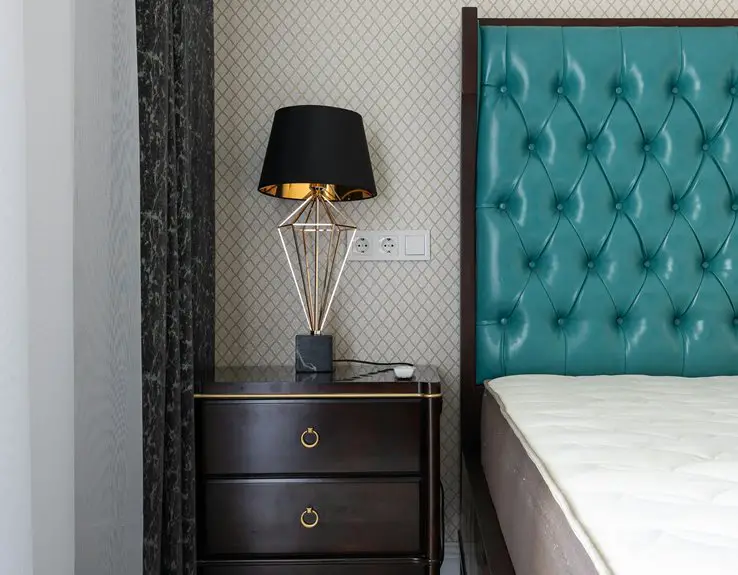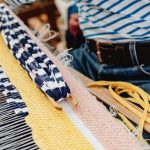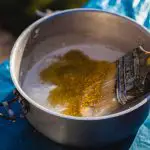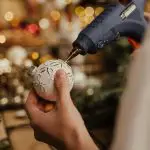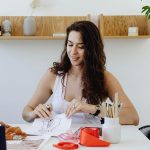To create perfect pleats in your upholstery projects, start by choosing medium-weight, tightly woven fabrics for crisp folds. Gather sharp scissors, strong thread, and a staple gun to handle thick layers. Measure and mark pleat lines carefully with removable chalk, then fold and pin pleats precisely, keeping edges aligned. Sew each pleat securely with small backstitches to prevent slippage. Mastering these basics sets a solid foundation before exploring advanced techniques and finishing details.
Table of Contents
Key Takeaways
- Choose medium-weight, tightly woven fabrics like twill or linen blends to maintain crisp and lasting pleats.
- Accurately measure and mark pleat lines using rulers and removable fabric markers on a flat surface.
- Fold pleats precisely along marked lines, pinning perpendicularly inside the folds to prevent shifting and distortion.
- Use strong upholstery thread and backstitch at pleat edges to securely hold pleats without puckering.
- Prepare all necessary tools, including sharp scissors, upholstery needles, and stabilizers, before starting the project.
Choosing the Right Fabric for Pleats
Fabric choice plays an essential role in achieving crisp, lasting pleats in upholstery.
You’ll want to pick a fabric that holds shape well without being too stiff or too flimsy. Medium-weight fabrics like twill, velvet, or linen blends work great because they balance flexibility and structure.
Choose fabrics that hold shape—medium-weight options like twill, velvet, or linen blends offer the perfect balance.
Avoid slippery materials like silk or very stretchy knits—they can make pleats slip out of place. Also, consider the weave; tight weaves provide better support for sharp pleats.
If you’re working on furniture that sees daily use, choose durable fabrics that resist wear and maintain pleat definition over time.
Finally, test a small swatch by folding pleats to see how the fabric behaves before committing, ensuring your pleats stay neat and sharp.
Tools and Materials Needed for Upholstery Pleating
To create perfect pleats, you’ll need the right tools and materials at hand.
Essential upholstery tools like fabric scissors, a staple gun, and measuring tape make the process smoother.
Choosing proper materials, including your fabric and thread, is just as important to guarantee durability and a clean finish.
Essential Upholstery Tools
Creating perfect pleats requires having the right tools at your fingertips. You’ll need precision and control, so gather these essentials before starting your upholstery project. Sharp scissors help you cut fabric cleanly, while a staple gun secures pleats firmly in place. Measuring tape guarantees accuracy in spacing, and a sewing needle or machine is vital for reinforcing pleats when needed. A chalk or fabric marker lets you mark fold lines clearly. Here’s a quick tool overview:
| Tool | Purpose | Tip |
|---|---|---|
| Sharp Scissors | Clean fabric cutting | Keep blades sharp |
| Staple Gun | Fast securing | Use appropriate staples |
| Measuring Tape | Accurate measurements | Double-check measurements |
| Fabric Marker | Mark fold lines | Choose washable marker |
With these tools ready, you can create crisp, professional pleats efficiently.
Choosing Proper Materials
Selecting the right materials plays an essential role in achieving neat and durable pleats in your upholstery. Start with choosing a fabric that holds shape well, like medium-weight cotton, linen, or polyester blends.
Avoid overly stretchy or slippery fabrics, as they can cause your pleats to lose definition. You’ll also need strong, matching thread to secure the pleats without breaking or puckering.
For backing, consider using interfacing or stabilizer to add structure and prevent fabric distortion. Don’t forget upholstery needles and pins designed to handle thick layers without damaging your materials.
Measuring and Marking Pleat Lines Accurately
Accurate measurement and marking lay the foundation for perfect pleats in upholstery. Start by determining your pleat width and spacing, then use a clear ruler or measuring tape to mark these intervals precisely on your fabric.
Work on a flat surface to avoid distortion. Use tailor’s chalk or a fabric marker that won’t bleed or stain, guaranteeing your marks are visible but easily removable. Mark both the front and back sides if necessary, so you maintain accuracy throughout sewing.
Double-check your measurements before cutting or folding to prevent mistakes. Taking your time with this step guarantees that your pleats will align evenly, creating a professional and polished finish in your upholstery project.
Techniques for Folding and Pinning Pleats
Fold each pleat carefully along the marked lines, ensuring the edges align perfectly to maintain uniformity.
Precision here sets the foundation for a polished look. Once folded, hold the pleat in place before pinning to avoid shifting fabric layers.
Use these techniques to secure your pleats neatly:
- Insert pins perpendicular to the fold for stronger hold and easy removal.
- Place pins slightly inside the pleat, not at the edge, to prevent distortion.
- Use fine, sharp pins to avoid damaging delicate upholstery fabrics.
Sewing and Securing Pleats in Upholstery
Once your pleats are pinned securely, it’s time to sew them in place to keep everything neat and stable. Use a strong upholstery thread and a sharp needle or your sewing machine’s heavy-duty setting.
Start stitching from the top of each pleat, sewing along the fold lines to maintain crisp edges. Be sure to backstitch at the beginning and end to lock the stitches. For extra strength, sew a few small tacking stitches through the pleat’s base where it meets the fabric backing. This prevents shifting during upholstery assembly.
Keep your stitches consistent and close enough to hold the fabric firmly without puckering. By carefully sewing and securing pleats, you’ll guarantee your upholstery maintains its structured, polished look throughout use.
Finishing Touches to Ensure Durable and Neat Pleats
To make sure your pleats stay crisp and strong, you’ll need to secure the edges carefully and pick stitching that can handle wear.
Choosing the right thread and stitch type helps maintain both durability and appearance.
Finally, keeping the pleat shape consistent will give your upholstery a polished, professional look.
Securing Pleat Edges
Three key methods will help you secure your pleat edges effectively, ensuring they stay crisp and durable over time.
First, use fabric glue sparingly along the inside folds to keep layers from shifting without adding bulk.
Second, apply small, discreet hand stitches at the pleat tips to lock the folds in place, preventing unraveling.
Third, consider inserting lightweight interfacing inside the pleat edges to add structure and maintain shape.
- Apply fabric glue on inner folds for subtle hold
- Hand-stitch pleat tips for long-lasting security
- Use interfacing to reinforce and shape pleats
Choosing Durable Stitching
Selecting the right stitching technique plays a crucial role in keeping your pleats both durable and neat. You want stitches that hold fabric firmly without puckering or weakening the fold. Consider these common stitching options for upholstery pleats:
| Stitch Type | Strength | Best For |
|---|---|---|
| Lockstitch | High | Heavy fabrics |
| Slipstitch | Medium | Invisible seams |
| Backstitch | Very high | Reinforcement areas |
Lockstitch is great for sturdy, lasting pleats, while slipstitch lets you hide stitches for a polished look. Backstitch offers extra strength where pleats face stress. Match your stitching choice to fabric type and use. By choosing durable stitching wisely, you’ll guarantee your pleats stay crisp and secure through everyday wear.
Maintaining Pleat Shape
Although stitching secures your pleats, maintaining their crisp shape requires careful finishing techniques.
To keep your pleats looking neat and durable, you need to reinforce and protect them beyond just sewing.
Here’s how you can maintain perfect pleats:
- Press with steam: Use a hot iron and steam to set the pleats firmly in place, but avoid over-pressing to prevent fabric damage.
- Apply fabric starch or sizing: Light sprays add stiffness, helping pleats hold their shape longer, especially on soft fabrics.
- Topstitch selectively: Add discreet topstitching along pleat edges for extra stability without compromising design.
Frequently Asked Questions
Can Pleats Be Added to Existing Upholstery Without Removing Fabric?
When push comes to shove, adding pleats without removing fabric can be tricky. You can create surface pleats by tacking or pinching fabric, but for true, lasting pleats, some fabric adjustment is usually necessary.
How Do Pleats Affect the Durability of Upholstery Over Time?
Pleats can add style but may create stress points in fabric over time. If you reinforce seams and use durable materials, you’ll maintain upholstery strength and longevity without compromising the look.
What Are Common Mistakes to Avoid When Creating Upholstery Pleats?
Don’t worry about your pleats looking messy; avoid common mistakes like uneven folds, skipping pinning, and using the wrong needle. You’ve got this—just measure carefully, pin securely, and sew slowly for flawless results.
Are There Specific Upholstery Styles That Work Best With Pleats?
You’ll find pleats work best with traditional and classic upholstery styles, adding elegance and texture. They suit tufted and tailored designs, enhancing structured pieces. Avoid overly casual or modern styles, where pleats might feel out of place.
How Do Environmental Factors Impact Pleated Upholstery Fabric?
You’ll find humidity can cause pleats to lose shape or wrinkle, while sunlight might fade colors and weaken fabric. So, you’ll want to control these factors to keep your pleated upholstery looking sharp and vibrant.
- Does Chiffon Fabric Stink - July 15, 2025
- Does Chiffon Fabric Affect the Economy - July 15, 2025
- Does Cotton Fabric Have a Nap - July 15, 2025

